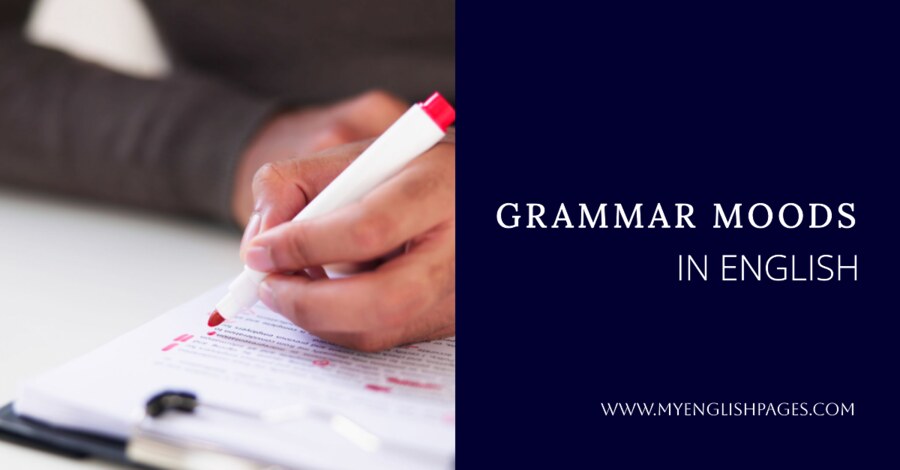Table of Contents
Understanding grammar moods is essential for mastering English communication. Moods help express the speaker’s attitude and the intention behind a sentence. You can communicate more precisely and effectively by learning to recognize and use different moods.
Let’s break down the main grammar moods in English, with clear explanations, examples, and tips to enhance your learning.
What Are Grammar Moods?
Grammar moods reflect the speaker’s attitude or the purpose of a sentence. They help convey whether someone is stating a fact, asking a question, giving a command, expressing a wish, or describing a possibility. For example:
- “I am happy” (indicative) states a fact.
- “Be happy!” (imperative) gives a command.
- “I wish I were happy” (subjunctive) expresses a wish.
- “If I were happy, I would smile more” (conditional) describes a possibility.
These examples illustrate how moods change the meaning and intention of sentences. Understanding grammar moods is essential for clear and effective communication, as they shape the tone and meaning of your words.
Grammar Moods in English with Examples
Grammar moods in English help convey the speaker’s attitude or the purpose of a sentence. There are four main types of grammar moods: indicative, imperative, subjunctive, conditional, and interrogative.
Each mood serves a unique function, whether it’s stating a fact, giving a command, expressing a wish, or describing a hypothetical situation.
In the following sections, we’ll explore each type in detail, along with clear examples to help you understand and use them effectively.
1. Indicative Mood
The indicative mood is the most commonly used mood in English. It is used to state facts, ask questions, or express opinions. This mood is straightforward and is often the default in everyday communication.
Examples:
- She loves reading books.
- Are you coming to the party?
- They finished their homework early.
Tip: The indicative mood is used in both positive and negative statements, as well as in direct questions.
2. Imperative Mood
The imperative mood is used to give commands, make requests, or offer invitations. It often omits the subject (usually “you”) and focuses on the action.
Examples:
- Close the door.
- Please help me with this task.
- Come to my birthday party!
Tip: The imperative mood can sound direct, so adding “please” softens the tone and makes requests more polite.
3. Subjunctive Mood
The subjunctive mood expresses hypothetical situations, wishes, demands, or suggestions. It is often used in formal or literary contexts and has unique verb forms, such as “be” instead of “am/is/are” and “were” instead of “was.”
Examples:
- I wish I were taller.
- It’s important that she be on time.
- If he were here, he would help.
Tip: The subjunctive mood is less common in modern English but is still important for expressing unreal or hypothetical scenarios.
4. Conditional Mood
The conditional mood describes situations that depend on a condition. It often uses modal verbs like “would,” “could,” or “might” and is closely related to conditional sentences.
Examples:
- If you study, you will pass the test. (First conditional)
- She would travel more if she had time. (Second conditional)
- They could join us if they finished work early. (Third conditional)
Tip: Conditional sentences are divided into four types (zero, first, second, and third), each expressing different levels of possibility or reality.
5. Interrogative Mood
The interrogative mood is used to ask questions. It helps gather information, clarify doubts, or engage in conversation.
Examples:
- Did you see that movie?
- What are you doing?
- Can you help me?
Tip: Questions can be formed by inverting the subject and verb (e.g., “Are you coming?”) or by using question words like “what,” “why,” or “how.”
Why Are Grammar Moods Important?
Grammar moods are essential because they allow speakers and writers to convey their attitudes, intentions, and purpose effectively. Here’s how they contribute to clear and precise communication:
- Express Attitude and Intent:
Grammar moods help convey the speaker’s attitude toward what they are saying. For example:- Indicative Mood: States facts or opinions (The sky is blue).
- Imperative Mood: Gives commands or requests (Close the door).
- Subjunctive Mood: Expresses wishes, suggestions, or hypotheticals (I wish I were there).
- Conditional Mood: Describes possibilities dependent on conditions (If I had time, I would help).
- Interrogative Mood: Asks questions (Did you see the movie?).
- Clarify Meaning:
Using the correct mood ensures that the listener or reader understands the speaker’s intention. For example:- Be quiet (imperative) clearly gives a command.
- I suggest that he be quiet (subjunctive) expresses a suggestion.
- Is he quiet? (interrogative) seeks information.
- Enhance Tone and Politeness:
Moods help shape the tone of communication, making it formal, polite, direct, or casual. For example:- Please help me (imperative) is more polite than Help me.
- If you could help me, I’d appreciate it (conditional) softens a request.
- Enable Hypothetical and Abstract Thinking:
Moods like the subjunctive and conditional allow us to discuss unreal, hypothetical, or abstract ideas. For example:- If I were rich, I would travel the world (subjunctive + conditional).
- It’s important that he be honest (subjunctive).
- Improve Writing and Speaking Skills:
Mastering grammar moods makes your communication more polished, accurate, and professional, whether in writing or speaking.
Common Mistakes to Avoid
- Confusing the Subjunctive and Indicative Moods:
- Incorrect: If I was you, I would go.
- Correct: If I were you, I would go.
- Overusing the Imperative Mood:
- Avoid sounding too direct in formal contexts. Instead of saying, “Send me the report,” you could say, “Could you please send me the report?”
- Misusing Conditional Sentences:
- Ensure the correct tense is used for each type of conditional. For example, in the second conditional, use the past tense in the “if” clause and “would” in the main clause.
Quick Reference Table
| Mood | Purpose | Example |
|---|---|---|
| Indicative | State facts, ask questions, express opinions | She loves reading books. |
| Imperative | Give commands, make requests, offer invitations | Close the door. |
| Subjunctive | Express hypotheticals, wishes, suggestions | I wish I were taller. |
| Conditional | Describe situations dependent on a condition | If you study, you will pass the test. |
| Interrogative | Ask questions | Did you see that movie? |
Practice Time!
Test your understanding with this exercise:
Identify the Mood in Each Sentence:
- Please bring me a glass of water.
- If I were rich, I would travel the world.
- She is studying for her exams.
- Close the window before you leave.
- I suggest that he be more careful.
- Did you finish your homework?
- If it rains, we will cancel the picnic.
- Let’s go to the park this afternoon.
- It’s important that everyone arrive on time.
- Can you pass me the salt, please?
FAQs
What are the moods in English grammar with examples?
Grammar moods in English are categories that reflect the speaker’s attitude or the purpose of a sentence. The main moods are:
– Indicative Mood: Used to state facts, opinions, or ask questions.
Example: She is reading a book.
– Imperative Mood: Used to give commands, make requests, or offer invitations.
Example: Please close the door.
– Subjunctive Mood: Used to express hypothetical situations, wishes, suggestions, or demands.
Example: I wish I were there.
– Conditional Mood: Used to describe actions that depend on a condition.
Example: If I had time, I would help you.
– Interrogative Mood: Used to ask questions.
Example: Did you finish your homework?
How many moods are in grammar?
There are five main moods in English grammar:
– Indicative
– Imperative
– Subjunctive
– Conditional
– Interrogative
What is the difference between mood and tense?
– Mood reflects the speaker’s attitude or the purpose of a sentence (e.g., stating a fact, giving a command, expressing a wish).
– Tense indicates the time of an action (past, present, or future).
Example 1: She reads books. (Present tense, indicative mood)
Example 2: If she had time, she would read more. (Past tense, conditional mood)
How do I identify the mood of a sentence?
To identify the mood of a sentence, look at the verb form and the sentence’s purpose:
– Indicative: States a fact or asks a question.
Example: He is happy.
– Imperative: Gives a command or request.
Example: Be quiet.
– Subjunctive: Expresses a wish, suggestion, or hypothetical situation.
Example: I wish I were there.
– Conditional: Describes an action dependent on a condition.
Example: If I were you, I would go.
– Interrogative: Asks a question.
Example: Did you see the movie?
Final Thoughts
Grammar moods might seem complex at first, but with practice, they become a natural part of your language use. You’ll enhance your writing and speaking skills by recognizing and applying these moods. This will make your English sound more polished and accurate.


